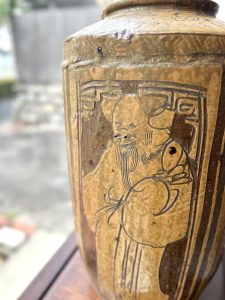中国では人気のキャラクター?(愛知県名古屋市千種区姫池通 骨董買取 古美術風光舎)
2024.07.24
皆さまこんにちは。スタッフHでございます。
今朝、出勤途中で見かけた沢山の日傘。最近は小さな子供から大人まで、また性別問わず日傘は必需品となっているようですね。様々な色や形のものを見かけました。サングラスに帽子、日焼け防止用マスクなど強い日差しに対するグッズがあふれていますが、パッと差すだけの日傘は中々手放せません。少し荷物にはなりますが…。
さて今、風光舎の入り口のウインドウには大きな中国の花入れが飾られています。交趾焼(こうちやき)と呼ばれるものです。

交趾とは現在のベトナム中部を指し、この地方から南方ルートを通り日本に来航した貿易船、「交趾船」によってもたらされたことから交趾焼と呼ばれるようになったとのこと。実際に制作されていた産地は明代後期の中国福建省南部の漳州(しょうしゅう)だとされています。
交趾焼は低火度で焼かれる鉛釉陶磁器で、緑(青)・黄・濃紫などの鮮やかな色彩と精緻な文様表現に特徴があります。現在は日本でも京都を中心に三彩の他にも瑠璃色や浅黄色など鮮やかな色彩のものがつくられています。
京都で交趾の生産が盛んに行われたのは江戸時代中期で、当時の中国清王朝の品が貿易船によって運び込まれ、京都の公家や僧侶、文人墨客と呼ばれる学者や茶人の興味を引き、愛用されました。
茶人が茶席で香合などとして使ったことにより、茶道の中心地である京都で陶工が交趾焼を作り始め、後に九谷など全国で作られるようになりました。現在は主に京都で作られており、陸や東アジアからもたらされた独特な色彩やデザインを今も引き継ぎ、京焼を代表する技法の一つともいわれています。
風光舎の交趾焼の花入れには四面に絵柄が描かれており、「猪八戒?」と思われる姿がまず目に留まりました。
もしやこの四面の絵は西遊記のメンバーかと思いきや、三蔵法師や孫悟空らしき姿は見あたりません。
猪八戒といえば子供の頃に観たTVドラマの「西遊記」の中で、常に何かを食べている食欲旺盛な姿が印象的で、そもそもどういうキャラクターなのかという疑問が湧いてきました。
猪八戒に関する言い伝えは様々あるようですが、もともとは天界の天の川の管理や大勢の水軍を指揮する天上の神様だったとか。しかしお酒好きで様々な悪事を繰り返し下界へ落とされました。ここまでで既に「えっ?」という感じの神様です。
下界で雌豚の体内に入り、太鼓腹、先のとがった耳、突き出た鼻の半人半豚の妖怪の姿で転生しました。西遊記ではその後三蔵法師と悟空に出会い天竺への旅を共にすることになっています。
日本ではあまり好意的に見られていない猪八戒ですが、欲望に正直で自由奔放な人間臭さが中国では人気で孫悟空人気を凌ぐほどだそうです。
猪八戒の名前には猪のもじが入っていますが、中国では猪は豚を意味し、十二支でも日本の猪は中国では豚で表されます。中国において豚は「多産」の象徴とされており、子だくさんになるという意味だけではなく「お金がお金を生んで裕福になる」という意味もあり縁起の良い動物とされています。
そういえば日本でも豚の形の貯金箱が昔は定番でしたね。豚の貯金箱からお金を取り出す時に、叩きつけて割るという、かなり荒っぽい方法がTVドラマなどで流れていました。一度やってみたかったのですが買ってもらえませんでした。今も売っているのでしょうか?
それでは、また次の機会に

Hello everyone. This is Staff H.
I saw many parasols on my way to work this morning. It seems that parasols have become a necessity for everyone these days, from small children to adults, regardless of gender. I saw many different colors and shapes. There are many goods to protect us from the strong sunlight, such as sunglasses, hats, and sun-protective masks, but a parasol that we can simply put on and off is something we can’t do without. It may be a bit cumbersome, but….
A large Chinese flower vase is displayed in the window at the entrance of the Fuhkosha. It is called “Kochi-yaki.
Kochi-yaki was brought to Japan by “Kochi-ship,” a trading ship that came to Japan from this region via the southern route. It is said that the actual production area was in Shouzhou in the southern part of Fujian Province in China in the late Ming Dynasty.
Koji ware is lead-glazed porcelain fired at low temperatures and characterized by vivid colors such as green (blue), yellow, and deep purple and exquisite patterns. Currently in Japan, especially in Kyoto, other vivid colors such as lapis lazuli and asagi are being produced in addition to sansai.
The production of kojiki in Kyoto flourished in the mid-Edo period (1603-1868), when items from the Qing Dynasty in China were brought in by trading ships and became the favorite of Kyoto’s court nobles, Buddhist monks, scholars called “literati” and “bokaku” (writers and artists), and tea masters.
Tea masters used them as incense containers at tea ceremonies, and potters in Kyoto, the center of the tea ceremony, began to make koji-yaki pottery, which later came to be made throughout Japan, including Kutani. Today, koji-yaki is mainly made in Kyoto, where it still retains the unique colors and designs brought from Riku and East Asia, and is considered one of the most representative techniques of Kyoyaki pottery.
Fumikosha’s koji-ware flower vases have designs painted on all four sides. The first thing that caught my eye was the figure of what appeared to be “Cho Hakkai,” or “The Eight Preceptors of Wild Boar.
I wondered if the four paintings were members of the Journey to the West, but I could not find any figures that looked like Sanzang-houshi or Sun Wukong.
Speaking of Cho Hakkai, the TV drama “Journey to the West,” which I watched as a child, left a strong impression of a man with a voracious appetite who was always eating something, which led me to wonder what kind of character he was.
There are various legends about Choha-kai. Originally, he was a heavenly god who managed the Milky Way in the heavenly realm and commanded a large navy. However, he loved to drink and repeatedly did various evil deeds, and was cast down to the lower realms. So far, he is already a “What? He is a god with a “what?” feeling.
In the lower world, he entered the body of a sow and was reincarnated as a half-human, half-pig demon with a drum belly, pointed ears, and a protruding nose. In the Journey to the West, he is supposed to meet Sanzo and Goku and travel with them to Jersey.
Although Choha-kai is not viewed favorably in Japan, his honesty with his desires and his free-spirited, human-like nature are said to be popular in China, even more so than Sun Wukong’s popularity.
Although his name contains the Chinese character for boar, in China boar means pig, and in the twelve signs of the Chinese zodiac, the Japanese boar is represented by the Chinese pig. In China, the pig is a symbol of “fertility” and is considered a lucky animal not only because it means to have many children, but also because it means “money begets money and makes you wealthy.
Come to think of it, pig-shaped piggy banks used to be a standard item in Japan as well. When taking money out of the piggy bank, I used to smash it and break it, which is a very rough way of taking money out. I wanted to try it once, but they did not buy it. Do they still sell them now?
Well, I’ll see you next time.
*******************
ご実家の整理やお片付けなどをされている方のご相談などが多くございます。
お片付けなどくれぐれもご無理のないようになさってくださいませ。
風光舎では古美術品や骨董品の他にも絵画や宝石、趣味のお品など様々なジャンルのものを買受しております。
お片付けをされていて、こういうものでもいいのかしらと迷われているものでも、どうぞお気軽にご相談下さいませ。
また風光舎は、出張買取も強化しております。ご近所はもちろん、愛知県内、岐阜県、三重県その他の県へも出張いたします。
まずは、お電話お待ちしております。
愛知県名古屋市千種区姫池通
骨董 買取【古美術 風光舎 名古屋店】
TEL052(734)8444
10:00-18:00 OPEN
#出張買取#骨董#古美術#骨董品#絵画#版画#茶道具#刀剣#彫刻

